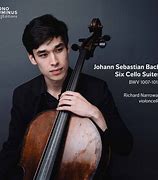
Richard Narroway. Bach Cello Suites. Sono Luminus CD SLE-70010.
Recorded at: Shelmerdine Studio, Melbourne Grammar School Victoria, Australia. Release 2017.
Recorded June 29th –July 4th 2015.
Richard Narroway plays a cello made in 1930 by Carl Becker Snr.
Intoduction.
I come across a couple of assumptions quite often. Firstly, that the best recordings of the Suites are by the “big” names. Secondly, that a performer needs to pay his/her dues. The implication being that “The knowledge” is acquired over time to produce a worthy recording of the Suites.
I am suggesting this recording by Narroway provides evidence that these should be redundant. To these two I would add a third. That the best sounding cellos are made by Stradivarius, Montagnana, Amati and Goffriller to name a few.
On the basis of this recording, I would suggest this also needs review. I don’t question the supremacy of cellos by the above luthiers, just the difference in sound quality does not justify the difference in value. I should add that I have never come across a valuer of instruments who took into account the sound of the instrument!
The up side of this situation is that it can be possible to find a really good sounding cello at reasonable price if it is less desired by collectors and speculators! A look on the Tarisio web site leads me to guess that the Becker cello would be worth a six figure sum-just! So a ten fold difference from the well known names above.
The Cellist.
Richard Narroway is an Australian, who has trained and worked in both his home country and America. He would have been close to 24 years old when he started work on the Suites. In fact this recording is his debut CD!
He joins an illustrious list of other cellists such as Yo Yo Ma, Ophelie Gaillard, Pieter Wispelwey and Isang Enders who first recorded the Suites in their 20s. The first three of these have also gone on to record at least one other version.
I strongly recommend readers to Narroway’s web site. This contains much of the information contained in the very worthy booklet which he has authored
https://www.richardnarroway.com
The Recording.
The cello has a lovely open airy sound, slightly earthy but very resonant. It is captured in the middle of the soundstage very clearly with great presence. I suspect the microphone placement was pretty close but the listener is not troubled by too much breathing and finger board noise.
However, in Sarabandes during quieter moments and at the end, the movement of bow on the string becomes obvious. This then picks up very slight unevenness in the bowing. This might be the penalty paid for the great dynamic variations that Narroway introduces into his playing.
Summarising, there is the feel of a live recording.
The music.
In general terms I found this recording very exciting and a riveting listen!
I feel it fair to say that as we get older, we become more risk averse. We rely on experience to warn us away from rashness. I feel Narroway’s youth leads him to experiment more with different speeds, rhythm, and dynamics which benefit the listener. He seems less constrained by what has gone before.
As detailed in his notes the player uses a Baroque style of play. There is very precise articulation, plenty of ornamentation (in surprising places) and rhythmic play that supports the notion of dance where appropriate.
The cello set up is modern. This allows huge variation in dynamics and I became very aware of different voices.
No I am not getting auditory hallucinations!
In the sixth Prelude I heard a bouncy aggressive voice at the beginning. This was followed by a languid smooth romantic voice in the middle. Towards the end I picked up a tender quiet and reflective voice. This is achieved I sense through variation of both dynamics and tonality.
I would pick out the first five Gigues as highlights. Narroway tends to move straight into them from the preceding movement without any significant pause. Highly effective as emphasises the leaps of this dance. The Courantes tend to be surprisingly measured considering the pace of the Preludes and Gigues, but are well articulated with again plenty of ornamentation.
Slight reservations.
The Allemandes tend to be quite slow as do the Sarabandes.
This is where I have some slight reservations in that I had a sense of meandering at times. Nevertheless, the playing was beautifully shaped and emotive.
I particularly liked and was intrigued by the fifth Suite Prelude. Many performers play the first part in the style of a long continuous extemporisation.
Narroway plays this part with very well defined short phrases usually beginning after the second beat, and ending on the first beat of the next bar. To me it hints at the fugal section to come and is a welcome change.
Sadly, for some reason, (maybe lack of time?) the sixth Suite seems to become a bit untidy after the impressive Prelude. Thus, the Courante and Gigue fail to excite as I was hoping.
Up to this point I found no issues with intonation or any technical matters. There is a live recording of Narroway playing the sixth Suite on You Tube which does impress as well but only covers the first three movements. Could this be significant?
Conclusion.
In summary I would strongly recommend this recording for the quality of the sound and the interpretation. I venture to suggest, it is a little different without causing offence to traditionalists!
One little quirk! The booklet running order for disc one is Suites 1,2 &6. On the disc it is actually 1,3 &6. The actual running order would seem to make more sense as it gives us a disc with the up beat Suites and one with the more solemn dark Suites.
I am going to keep an eye out for this cellist as I feel sure he will progress well over the next few years.
Charles.